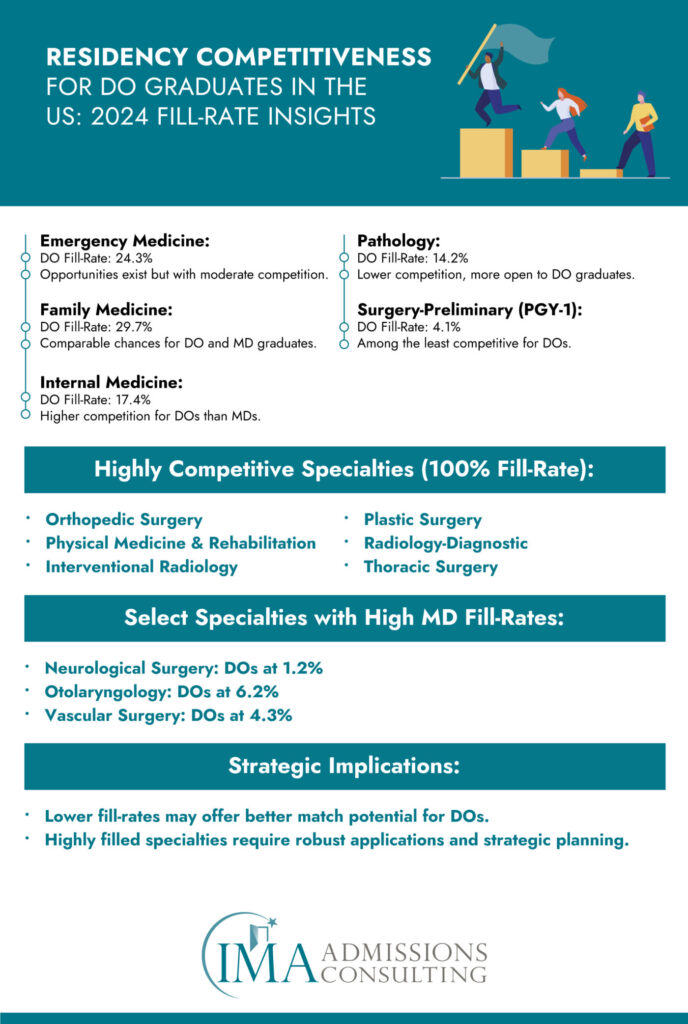Ready for Your DO Residency? A Match Rates Guide for DO Students
When embarking on a career in osteopathic medicine, one of the most significant steps is the transition from medical school to residency. This pivotal stage not only shapes your professional journey but also solidifies your expertise in a particular medical specialty. For students of osteopathic medicine, understanding the dynamics of match rates for Osteopathic Schools is pretty important. Let’s take a look at how these rates affect your residency placement. If this is your first time looking into match rates, we’ve given some explanations of the terms and concepts within the guide.
Osteopathic Medicine and the DO Schools with Best Match Rates
The match rate, a metric reflecting the percentage of graduates securing residency spots, varies among institutions and is influenced by a myriad of factors. It’s not simply a measure of a school’s quality but an indicator of the alignment between a school’s offerings and its students’ career objectives. The highest match rates are often found at schools that not only provide exceptional education but also foster strong support networks and offer ample professional opportunities.
While match rates are important, they shouldn’t overshadow personal preferences and professional goals when selecting a medical school. The essence of a successful match lies in the synergy between a student’s academic performance, clinical experiences, and personal aspirations.
Enhancing Your Match Prospects
To augment your chances of a successful match, consider the following strategies:
Clinical Experience
Seek rotations and externships in your desired specialty. Quality hands-on experience not only sharpens your skills but also demonstrates your commitment to your field.
COMLEX Scores
Perform exceptionally on the COMLEX exams. A strong performance can significantly bolster your residency application and set you apart from the competition.
Professional Development
Attend medical conferences and engage in continuous learning. These platforms offer insights into the latest industry trends and foster networking opportunities.
Interview Preparedness
Hone your interview skills. A residency interview offers you the stage to present your interpersonal skills and professional aptitude. Thorough preparation can make a substantial difference.
Understanding Match Rates for Osteopathic Medical Students
When medical students are ready to move on to their residency, they go through a process known as “matching,” where they are paired with residency programs that fit their qualifications and interests. To understand how often students from Doctor of Osteopathy (DO) schools get matched to a residency program compared to those from traditional medical schools (MDs), researchers looked at data from official medical matching organizations and graduate medical education councils over the years 2018 to 2023.
The Study Method
The study involved collecting information about the number of DO and MD students who applied for residency positions, their success in getting matched, and what residency program directors think of them. The success in matching was calculated by comparing the number of applicants to the number who got a residency spot. The researchers used various mathematical methods to analyze this data, considering a result significant if it had less than a 5% probability of being due to chance.
What the Research Found
Between 2020 and 2023, there was an increase in the number of DO students applying for surgical specialties. Despite this, DO students consistently had lower match rates compared to MD students in these specialties. For instance, in 2023, the overall match rate for DO students in certain surgical areas was about 53%, while it was about 74% for MD students.
The study revealed significant differences in match rates by specialty. For example, in neurosurgery, only about 31% of DO candidates were matched, compared to nearly 75% of MD candidates. In thoracic surgery, the match rate was about 17% for DOs versus 46% for MDs. Plastic surgery saw one of the largest gaps, with just over 4% for DOs compared to almost 69% for MDs. General surgery, vascular surgery, ENT (ear, nose, and throat), and orthopedics also showed notably higher match rates for MDs than for DOs.
Interestingly, the study found that DO students had a better chance of matching when the program director in the specialty was also a DO. This suggests that having more DOs in leadership positions within residency programs may improve match outcomes for DO candidates.
Simplified Takeaway
In simpler terms, while more DO students are applying for surgical residency positions, they’re still less likely to get matched compared to MD students. However, having DO leaders in residency programs seems to help DO students’ chances.
Key Phrases
- CCOM Match List: This refers to the list of residency matches from a College of Osteopathic Medicine, showing where students ended up for their residency training.
- Match Rates for Osteopathic Schools: This phrase describes the percentage of DO students who successfully secure a residency position after applying.
- Match Rate by Specialty: The term match rate by specialty indicates the likelihood of students getting a residency in specific medical fields, like surgery or pediatrics.
The findings of this study provide important insights for DO students looking to increase their chances of a successful match, particularly by choosing specialties with better match rates and advocating for more DO leadership in residency programs.
The Role of International Medical Aid
International Medical Aid (IMA) provides an array of services designed to support DO students in their journey to a successful match. From personalized consultations to mock interviews, IMA offers expertise and guidance at every step of the residency application process.
For those seeking more information on the support offered by IMA, including how to enhance the various components of your residency application, you are encouraged to contact us for further details and resources.
In osteopathic medical education, certain institutions stand out for their exceptional match rates. The DO Schools with best match rates have a strong track record of guiding students into their desired residency programs. Below is a curated list of DO schools that have distinguished themselves with outstanding match rates, reflective of their commitment to student success and the breadth of opportunities they offer for postgraduate medical training.
The Exemplary DO Schools with Best Match Rates
Campbell University School of Osteopathic Medicine
With an impressive match rate of 99.85%, graduates from CUSOM tend to pursue primary care fields such as internal medicine, family medicine, and pediatrics, along with other disciplines like anesthesiology and psychiatry.
Oklahoma State University College of Osteopathic Medicine
OSUCOM boasts a near-perfect match rate, having achieved a full 100% in six out of the past seven years, standing at 99.78%.
West Virginia School of Osteopathic Medicine
WVSOM graduates excel with a match rate of 99.75%, and a significant 60% secure their top residency program choices, surpassing the national average.
Kansas City University of Medicine and Biosciences College of Osteopathic Medicine
With a combined KCU-COM campus result of 99.6%, a substantial portion of their graduates secure placements in internal and family medicine residency programs.
Lake Erie College of Osteopathic Medicine
Spanning two campuses, LECOM achieves a combined match rate of 99.6%, showcasing the strength of their programs in Erie, Pennsylvania, and Bradenton, Florida.
A.T. Still University of Health Sciences - School of Osteopathic Medicine in Arizona
At a match rate of 99.5%, ATSU’s Arizona school openly shares the diverse array of specialties and locations where their graduates match, demonstrating the wide reach of their alumni.
Touro College of Osteopathic Medicine - Nevada
The Touro COM Nevada campus stands out among its counterparts with the highest four-year average match rate at 99.5%.
Edward Via College of Osteopathic Medicine
With campuses in Virginia, the Carolinas, and Auburn, VCOM graduates a large number of students into internal and family medicine, with a match rate of 99.38%.
University of Pikeville - Kentucky College of Osteopathic Medicine
UPIKE shows a match rate of 99.38%, with graduates branching out to residency programs across several states including Kentucky, Michigan, Ohio, and Illinois.
Idaho College of Osteopathic Medicine
ICOM’s graduates achieve a 99.3% match rate in a single year’s cycle, reflecting the school’s growing reputation.
A.T. Still University of Health Sciences - Kirksville College of Osteopathic Medicine
ATSU’s Kirksville campus sees two-thirds of its graduates entering primary care fields, with a match rate of 99.25%.
Rowan University School of Osteopathic Medicine
With a 99.25% match rate, 40–50% of Rowan’s graduates in recent years have found residency placements within New Jersey.
Des Moines University College of Osteopathic Medicine
Des Moines University offers a robust DO program with a 99.02% match rate and an overall graduation rate that is commendable.
Alabama College of Osteopathic Medicine
ACOM reports a 99.0% match rate, with students branching into 22 specialties across a vast geographic spread.
Michigan State University College of Osteopathic Medicine
MSUOM maintains a 99.0% match rate, with a high percentage of graduates, 76%, choosing to remain in Michigan for their residency programs.
For DO students, these schools represent not just educational institutions but gateways to fulfilling careers in medicine. The match rates are a testament to the schools’ dedication to providing quality education and ample professional opportunities.
Trends in DO Residency Program Competitiveness in the US
The landscape of medical residency programs within the United States is complex, with the level of competition often measured by the rate at which available positions are filled — known as fill-rates. These rates can give osteopathic graduates a glimpse into their chances of securing a spot in various specialties.

Assessing Opportunities for DO Graduates
Here’s a breakdown of fill-rates in some key medical specialties, indicating the level of competitiveness specifically for DO candidates:
Emergency Medicine: With a DO fill-rate of 24.3% and 3,010 positions offered, the pathway to emergency medicine shows a moderate level of competition for DO graduates.
Family Medicine: Demonstrating a nearly equal opportunity for both MD and DO graduates, family medicine had a DO fill-rate of 29.7%, signaling a balanced competitive field.
Internal Medicine: Internal medicine presented a significant difference in fill-rates, with DO students filling 17.4% of positions, suggesting a more competitive environment for DO graduates compared to MDs.
Pathology: With a fill-rate of 14.2% for DO students, pathology indicates a lower level of competition among DO graduates seeking positions in this specialty.
Surgery-Preliminary (PGY-1 Only): DO students experienced a fill-rate of 4.1%, marking it as one of the least competitive pathways for those pursuing a surgical specialty.
Highly Competitive Specialties for DO Graduate
Certain specialties reached a 100% fill-rate immediately after Match Week, illustrating a highly competitive scenario for DO students. These included Orthopedic Surgery, Physical Medicine & Rehabilitation, Interventional Radiology, Plastic Surgery, Radiology-Diagnostic, and Thoracic Surgery.
Comparing DO and MD Match Rates in Select Specialties
Some specialties witnessed notably higher fill-rates for MD graduates, which could impact DO students’ strategy when applying. For instance, Neurological Surgery had a DO fill-rate of only 1.2%, Otolaryngology at 6.2%, and Vascular Surgery at 4.3%. These numbers suggest that DO students may face more competition in these areas compared to their MD counterparts.
Implications for Residency Choices
Lower fill-rates in certain specialties suggest that DO students might have a higher chance of matching in those fields. Conversely, specialties with higher fill-rates, especially those completely filled, represent a more challenging arena requiring strategic applications and possibly broader geographical consideration.
For DO students, these trends are vital for making informed decisions about their residency applications. Engaging in thorough preparation, seeking mentorship, and leveraging resources such as professional residency consulting services can enhance the likelihood of securing a desired residency position.
Seeking Professional Guidance for Residency Applications
Navigating the match process can be daunting, but professional guidance can provide a significant advantage. International Medical Aid offers expertise in residency application preparation, providing services tailored to enhance your prospects. A strategic approach can streamline your journey, and with IMA’s support, the pathway to your residency match is clear.
For detailed assistance, scheduling a strategy call with our team of experts could be your first step toward a successful match. International Medical Aid provides Residency Application Services for a comprehensive understanding of how to fortify your application and strategies to navigate the match process effectively.
Frequently Asked Questions (FAQs)
What factors contribute to high match rates at DO schools?
High match rates can stem from targeted support systems, robust clinical networks, and alignment with high-demand specialties.
How can I improve my residency application?
Gain diverse clinical experiences, secure strong letters of recommendation, ensure your application documents are impeccable, and prepare thoroughly for interviews.
What services do academic consultants provide?
Our Academic Consultants offer tailored support, from application reviews to mock interviews, all designed to elevate your candidacy for residency programs.
Can I improve my chances of matching if I didn't match previously?
Yes, focus on strengthening your application, gaining additional experience, and possibly pursuing research or additional coursework.
What should I consider when creating a residency rank order list?
Your list should reflect your genuine preferences, balancing your career goals with the programs’ offerings and culture.
How can I choose the right DO school for me?
Look beyond match rates; consider curriculum, clinical rotation opportunities, faculty expertise, and alignment with your medical career aspirations.
What is the significance of the COMLEX-USA exams?
COMLEX-USA exams are critical in assessing osteopathic medical students’ readiness for residency and are integral to the match process.
Parting Thoughts
The path to residency is multi-faceted, demanding both academic excellence and a nuanced understanding of the match process. As a DO student, it is essential to engage in a holistic approach that encompasses academic achievements, clinical prowess, and strategic application processes.
International Medical Aid stands ready to assist you in enhancing your application and navigating the complexities of the match process. For those who aim for excellence in their residency match and beyond, IMA’s comprehensive services can serve as the cornerstone of your success.
Remember, the journey to a fulfilling residency and a rewarding medical career is a marathon, not a sprint. Equip yourself with knowledge, prepare with dedication, and embrace the journey with resilience. The right support, the right mindset, and the right tools can transform your aspirations into achievements.





